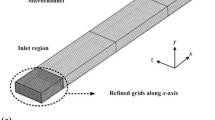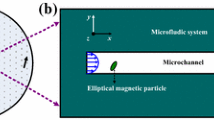Abstract
Efficient manipulation and capture of magnetic carriers in fluid stream require appropriate magnetic confinement devices whose performances are strongly dependent on the nature of the magnetic carriers. In this sense, we have performed a systematic investigation of the magnetic capture efficiencies for five commercially available superparamagnetic particles pumped along rectangular microfluidic channels using microelectromagnetic traps composed of planar circular current-carrying microwires and cylindrical ferromagnetic posts. In addition, in order to obtain a quantitative description of particle movement, we have implemented a numerical model for the dynamics of magnetic objects subjected to magnetic field gradients in conventional continuous-flow microfluidic devices. Fully 3D trajectories of the particles, effective cross-sectional areas of the microchannel as well as micro-electromagnet trapping efficiencies are compared to experimental measurements and a very good agreement is obtained. Finally, a simple and effective analytical model to determine the critical velocity, i.e. when the magnetic trapping device is no longer able to capture and hold 100% of the magnetic superparamagnetic particles, is also presented.






Similar content being viewed by others
References
Baselt DR, Lee GU, Natesan M, Metzger SW, Sheehan PE, Colton RJ (1998) A biosensor based on magnetoresistance technology. Biosens Bioelectron 13:731–739
Brzeska M, Panhorst M, Kamp PB, Schotter J, Reiss G, Puhler A, Becker A, Bruckl H (2004) Detection and manipulation of biomolecules by magnetic carriers. J Biotechnol 112:25–33
Choi J-W, Liakopoulos TM, Ahn CH (2001) An on-chip magnetic bead separator using spiral electromagnets with semi-encapsulated permalloy. Biosens Bioelectron 16:409–416
Deng T, Whitesides GM, Radhakrishnan M, Zabow G, Prentiss M (2001) Manipulation of magnetic microbeads in suspension using micromagnetic systems fabricated with soft lithography. Appl Phys Lett 78:1775–1777
Deng T, Prentiss M, Whitesides GM (2002) Fabrication of magnetic microfiltration systems using soft lithography. Appl Phys Lett 80:461–463
Dubus S, Gravel J-F, Le Drogoff B, Nobert P, Veres T, Boudreau D (2006) PCR-free DNA detection using a magnetic bead-supported polymeric transducer and microelectromagnetic traps. Anal Chem 78:4457–4464
Fonnum G, Johansson C, Molteberg A, Morup S, Aksnes E (2005) Characterisation of Dynabeads by magnetization measurements and Mössbauer spectroscopy. J Magn Magn Mater 293:41–47
Galassi M, Davies J, Theiler J, Gough B, Jungman G, Booth M, Rossi F (2006) GNU scientific library reference manual, 2nd edn. http://www.gnu.org/software/gsl/
Gijs MAM (2004) Magnetic bead handling on-chip: new opportunities for analytical applications. Microfluid Nanofluid 1:22–40
Happel J (1965) Low Reynolds number hydrodynamics: with special applications to particulate media. Prentice-Hall, Englewood Cliffs
Hsing I-M, Xu Y, Zhao W (2007) Micro- and nano- magnetic particles for applications in biosensing. Electroanalysis 19:755–768
Kim KS, Park J-K (2005) Magnetic force-based multiplexed immunoassay using superparamagnetic nanoparticles in microfluidic channel. Lab Chip 5:657–664
Lee CS, Lee H, Westervelt RM (2001) Microelectromagnets for the control of magnetic nanoparticles. Appl Phys Lett 79:3308–3310
Lee H, Purdon AM, Westervelt RM (2004) Manipulation of biological cells using a microelectromagnet matrix. Appl Phys Lett 85:1063–1065
Liu C, Lagae L, Wirix-Speetjens R, Borghs G (2007) On-chip separation of magnetic particles with different magnetophoretic mobilities. J Appl Phys 101:024913
Mikkelsen C, Bruus H (2005) Microfluidic capturing-dynamics of paramagnetic bead suspensions. Lab Chip 5:1293–1297
Mirowski E, Moreland J, Russek S, Donahue MJ (2004) Integrated microfluidic isolation platform for magnetic particle manipulation in biological systems. Appl Phys Lett 84:1786–1788
Pamme N (2006) Magnetism and microfluidics. Lab Chip 6:24–38
Ramadan Q, Samper V, Poenar DP, Yu C (2006a) Analytical model for the magnetic field and force in a magnetophoretic microsystem. Biosens Bioelectron 21:1693–1702
Ramadan Q, Samper VD, Ponar D, Chen Y (2006b) Fabrication of three-dimensional magnetic microdevices with embedded microcoils for magnetic potential concentration. J Microelectromech Syst 15:624–638
Rida A, Gijs MAM (2004) Dynamics of magnetically retained supraparticle structures in a liquid flow. Appl Phys Lett 85:4986–4988
Smistrup K, Hansen O, Bruus H, Hansen MF (2005) Magnetic separation in microfluidic systems using microfabricated electromagnets—experiments and simulations. J Magn Magn Mater 293:597–604
Smistrup K, Tang PT, Hansen O, Hansen MF (2006) Microelectromagnet for magnetic manipulation in lab-on-a-chip systems. J Magn Magn Mater 300:418–426
Unger MA, Chou H-P, Thorsen T, Scherer A, Quake SR (2000) Monolithic microfabricated valves and pumps by multilayer soft lithography. Science 288:113–116
Verpoorte E (2003) Beads and chips: new recipes for analysis. Lab Chip 3:60N–68N
de Vries AHB, Krenn BE, van Driel R, Kanger JS (2005) Micro magnetic tweezers for nanomanipulation inside live cells. Biophys J 88:2137–2144
Whitesides GM, Kazlauskas RJ, Josephson L (1983) Magnetic separations in biotechnology. Trends Biotechnol 1:144–148
Xia Y, Whitesides GM (1998) Soft lithography. Angew Chem Int Ed 37:550–575
Zaytseva NV, Goral VN, Montagna RA, Baeumner AJ (2005) Development of a microfluidic biosensor module for pathogen detection. Lab Chip 5:805–811
Acknowledgment
This work was supported by Defense Research and Development Canada’s Chemical, Biological, Radiological and Nuclear Research and Technology initiative (CRTI), Project 03-0005RD and the National Research Council of Canada.
Author information
Authors and Affiliations
Corresponding author
Rights and permissions
About this article
Cite this article
Le Drogoff, B., Clime, L. & Veres, T. The influence of magnetic carrier size on the performance of microfluidic integrated micro-electromagnetic traps. Microfluid Nanofluid 5, 373–381 (2008). https://doi.org/10.1007/s10404-007-0249-1
Received:
Accepted:
Published:
Issue Date:
DOI: https://doi.org/10.1007/s10404-007-0249-1




